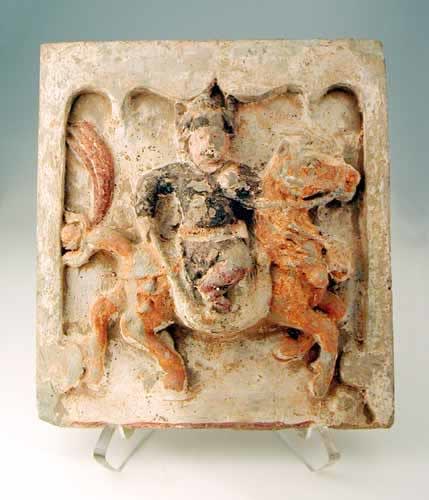Architectural Tile Featuring a Polo Player, 960 CE - 1279 CE
Painted Terracotta
11.5
H.712
The Song (also spelled Sung) Dynasty partially reunified the country after a period of turmoil following the fall of the T’ang. Historically, the Song are noted for their revival of...
The Song (also spelled Sung) Dynasty partially reunified the country after a period of turmoil following the fall of the T’ang. Historically, the Song are noted for their revival of the ancient Confucian beliefs, ushering a period known as Neo-Confucianism that would dominate Chinese (and later on Japanese) thought for the next several centuries. Although best known for their philosophical contributions, this decorative architectural tile attests to the rich artistic tradition that flourished under the enlightened rulers of the Song Dynasty. Presumably, such tile decorated the tombs of the royal elite and perhaps once adorned their palace during their lifetime. The tile depicts a horse and rider engaged in a polo match colorfully painted with an impressive amount of the original pigment still intact. Polo was a popular aristocratic pastime associated with the royalty, reinforcing the assumption that this tile once decorated a luxurious palace. No doubt, this subject matter reflects the vital importance of the horse in the defense and expansion of the empire as well as in economic matters. The strength and speed of the horse would have aided communication between far away provinces that is an essential factor of maintaining stability in a centralized government. Horses have been fabled creatures throughout Chinese history. In fact, they were venerated as ancestors of the mythological dragon. Horses were vital to defending the borders against barbarian invaders from the north. The need to import stronger and swifter horses from Central Asia (as opposed to the local Mongol Pony) was the primary factor in the establishment of the Silk Road, the economic lifeline of the ancient world that united the Chinese with Mediterranean cultures as early as the Han Dynasty. Clearly, horses were honored throughout Chinese history, a fact most elegantly reflected in their tomb sculptures. This fine painted panel is no exception. Expertly depicting the speed and grace of this majestic creature, this panel is both a splendid work of decorative art as well as a fitting memorial to the revered horse.
